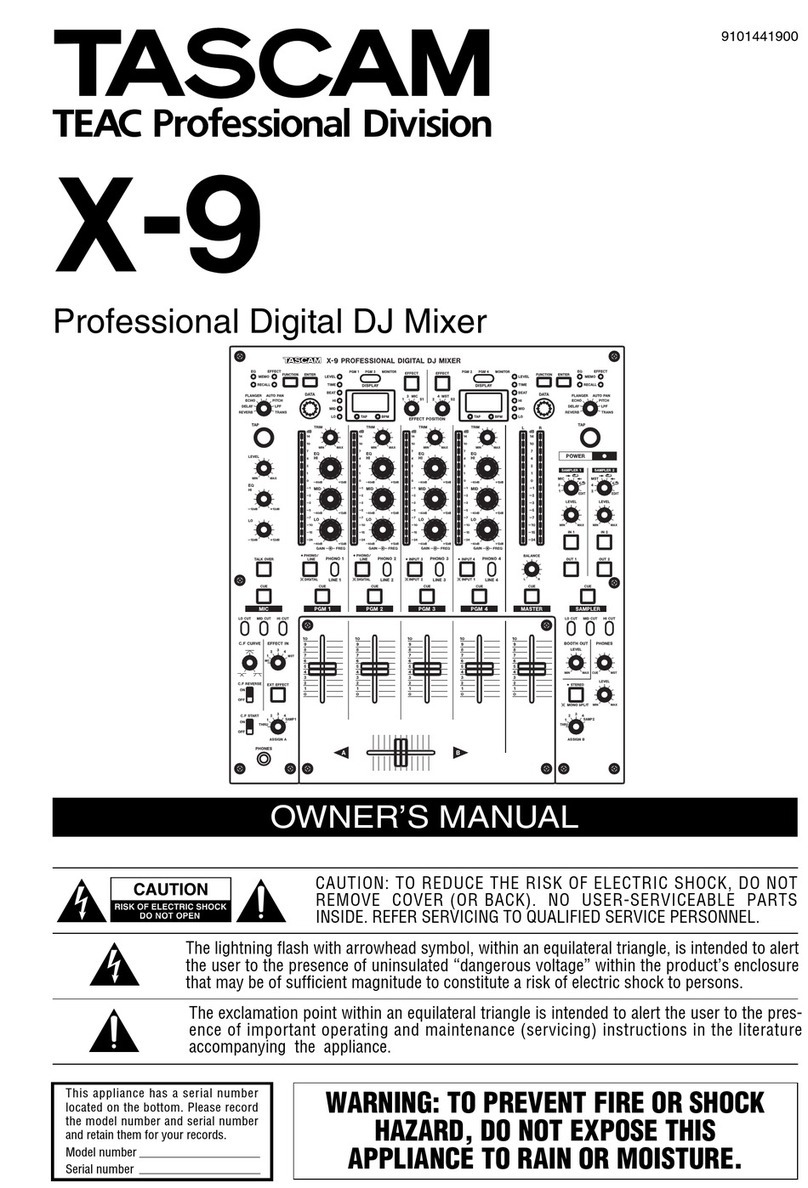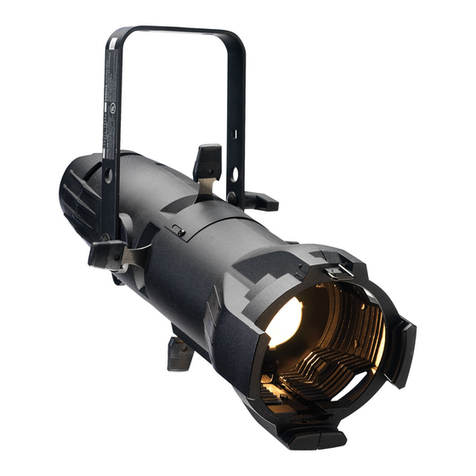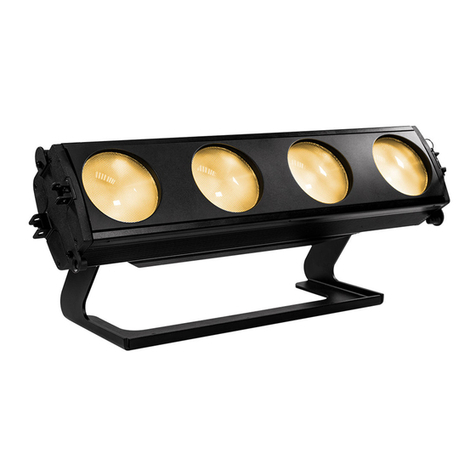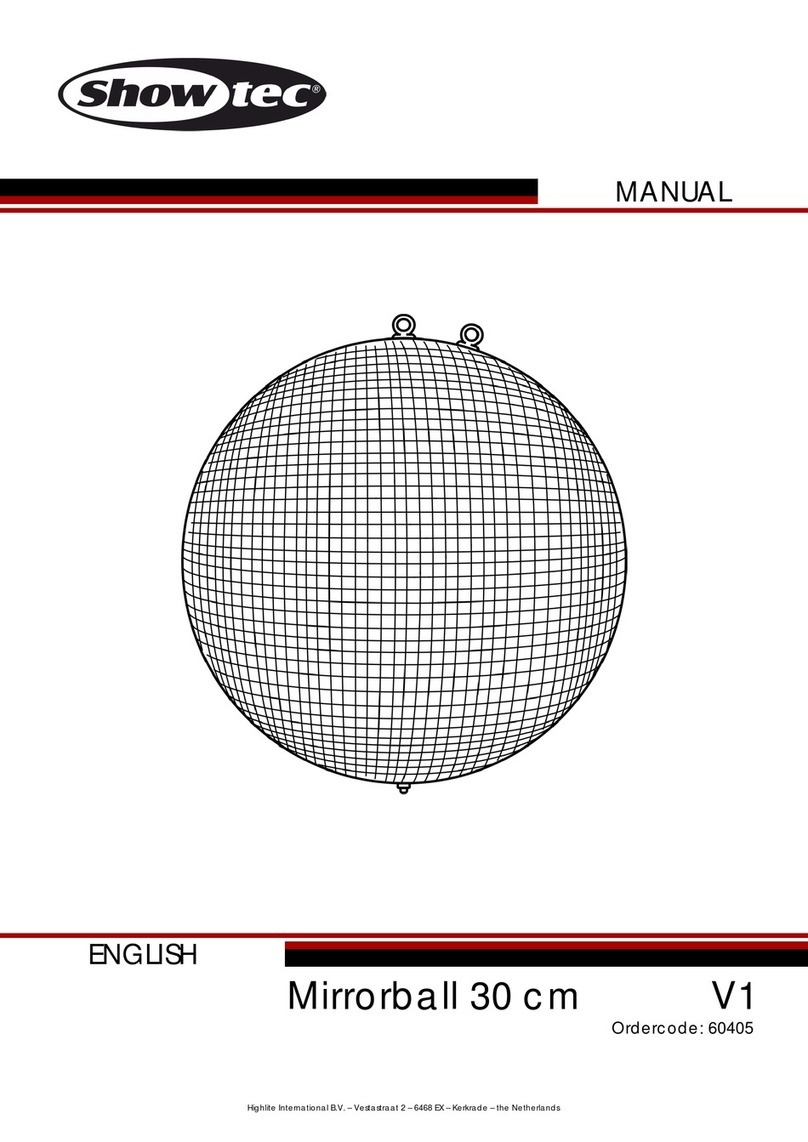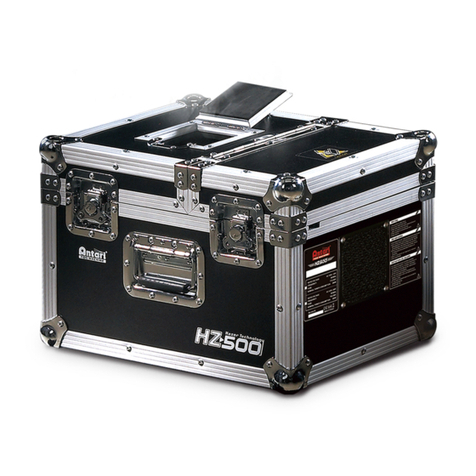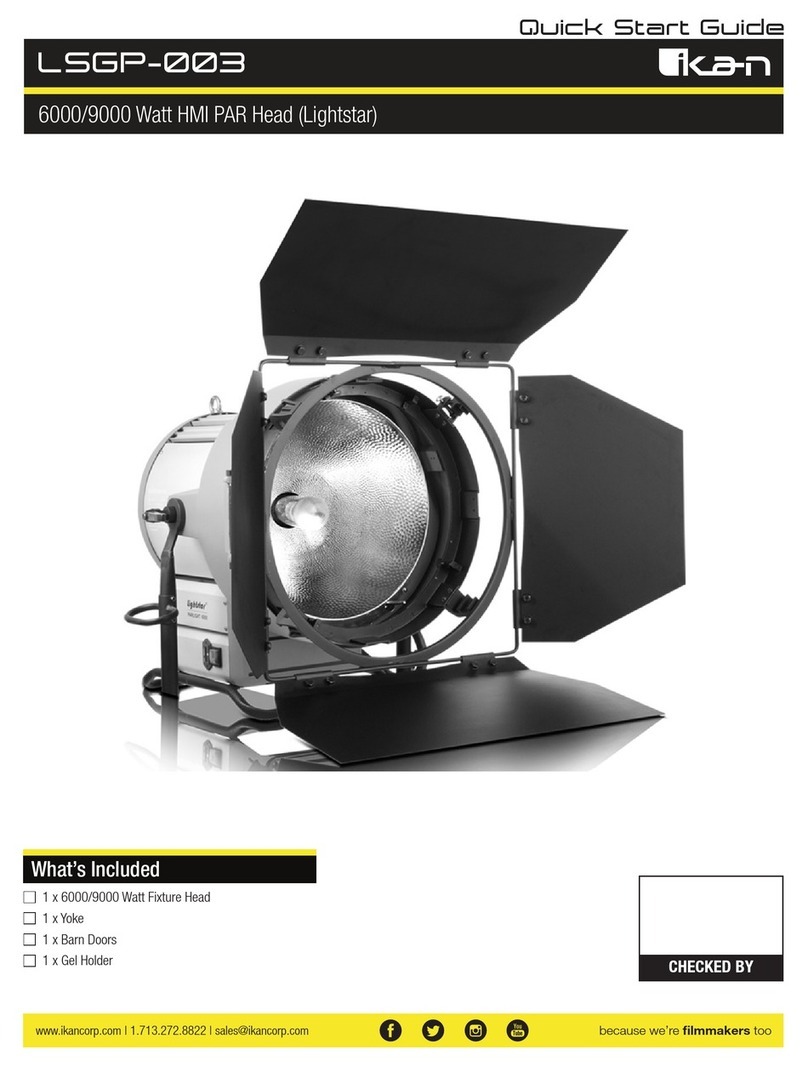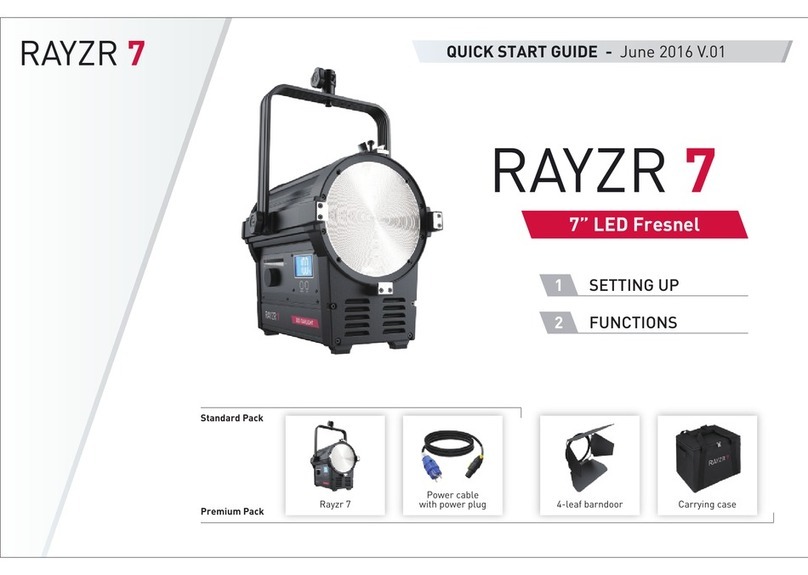TopLite International Merlin-C20 Operating instructions

Merlin ®-C20
MANUEL D’UTILISATION
Tables des matières
A. Introduction
B. Chapitre 1
Présentation générale du Merlin ®-C20
C. Chapitre 2
Installation du Merlin ®-C20
D. Chapitre 3
FONCTIONNEMENT DU Merlin ®-C20
Affichage LED
Assignation DMX – Réglages – Tests
Mode de fonctionnement
E. Chapitre 4
Entretien du Merlin ®-C20
F. Chapitre 5
Dépannage du Merlin ®-C20

A. Introduction
Vous venez d'acquérir un tout nouvel appareil Merlin ®-C20 de la marque Toplite et nous
nous en remercions. Dans ce manuel d’utilisation, il vous sera très facile de trouver toutes
les informations concernant la mise en place, le fonctionnement, l'entretien ainsi que le
dépannage de votre appareil.
Conditionnement
Après avoir retiré votre Merlin ®-C20 de son emballage, nous vous recommandons de
garder toutes les parties du carton d'emballage et de les conserver dans un endroit sec pour
une utilisation ultérieure, au cas où vous devriez rapporter l'appareil chez votre revendeur le
plus proche par exemple. Afin de vous garantir une prise en charge total de votre appareil si
des réparations éventuelles seraient à envisager, nous vous conseillons de ne pas jeter
l'emballage intérieur et extérieur.
Votre Merlin ®-C20 a été conçu pour une utilisation en intérieur seulement. Toute utilisation
contraire à celle indiquée précédemment pourrait entraîner des dommages sur l'appareil.
De plus, une mauvaise utilisation de l'appareil pourrait être à l'origine de la perte de
garantie. Conditions idéales de fonctionnement : Température entre -20 et +45 °C.
Avant de brancher et d'utiliser votre Merlin ®-C20, vous devez avoir fait toutes les
installations préliminaires. Nous vous conseillons de vous référer au chapitre 1 afin de vous
familiariser avec toutes les parties qui composent votre appareil.
Vous trouverez- ci dessous la liste des composants inclus dans votre Merlin ®-C20
1. 1 x Merlin ®-C20
2. 1 cordon d'alimentation de 1.5 mètres
3. 2 x supports de fixation
B. Chapitre 1
Présentation générale du Merlin ®-C20
Caractéristiques
* Roue de gobos: 4 gobos rotatifs + 3 gobos statiques + ouverture,
* Zoom manuel: 10 ou 18°
* 8 couleurs + ouverture, 8 split colors (demi couleurs)
* Strobe, Dimmer 0-100% et Blackout
* Mode musical, mode autonome, Master / Slave, 11 canaux DMX, inversion Pan / Tilt
* Pan: 520°
* Tilt: 245°
* Lampe: LED 20W blanc
* Dimensions (mm): 300 x 250 x 250
* Poids: 5.2 kg
Schéma 1. Vue de côté

Schéma 2. L'ouverture de la lentille et le réglage du focus
La bague Lentille-Focus peut tourner de gauche à droite et de droite à gauche afin de
pouvoir régler le focus. Le petit embout à la base du cône d'ouverture permet de régler
manuellement le zoom de 10 ou 18°. Afin de sélectionner le degré de votre choix,
poussez l'embout soit vers la gauche ou soit vers la droite. Il restera dans la position
choisie pendant l'utilisation de l'appareil et ce jusqu'au prochain changement du
réglage.
Schéma 3.Vue rapprochée de l'alimentation
Schéma 4. Porte fusible
Schéma 5. Retrait des capots latéraux et du cône supérieur pour le nettoyage des ventilateurs et
des lentilles ainsi que pour la vérification de la courroie de l'axe Y, du Dimmer/Shutter et enfin
des roues de couleurs et gobos.

Schéma 6. Retrait du capot d'accès à la base pour le nettoyage et la vérification de la courroie
de l'axe X
Schéma 7. Supports de fixation, poignées et points d'attaches pour le câble de sécurité
Schéma 8. Retrait du capot couvrant l'axe Y pour le nettoyage
C. Chapitre 2
Installation du Merlin ®-C20
Assemblage de la lentille et du focus et utilisation du focus pour la 1
ère
fois
1. Retirez le film de protection de la lentille. Nettoyez la lentille avec un chiffon doux et sec,
si possible comme ceux utilisés pour le nettoyage des verres de lunettes.
2. Puis, activez le mode TEST-GoBo (voir le chapitre 3) et ajustez le focus de l'appareil en
vous servant d'un mur ou autre surface plane (voir le schéma 2).
3. Enfin, retournez au mode de votre choix pour un fonctionnement normal.
Le porte fusible et le remplacement de fusibles
Votre Merlin ®-C20 est muni d’un fusible 2A déjà installé dans le porte fusible. Vous
trouverez également un fusible de rechange correctement situé à l'intérieur du porte fusible.
1. Pour changer les fusibles, assurez-vous que le commutateur soit sur OFF ou que
l'appareil soit débranché.
2. Puis, retirez le porte fusible à l'aide d'un couteau si nécessaire. Retirez le fusible usagé et
remplacez-le avec le nouveau fusible. (Voir les schémas 3 et 4). Remettre le porte fusible en
place.
3. Vous pouvez rallumer l'appareil. Si le nouveau fusible grille à l'instant même où vous
rallumez votre Merlin-C, ceci implique un problème plus important. Nous vous conseillons

de contacter votre revendeur pour des réparations par du personnel qualifié.
D. Chapitre 3
Installation du Merlin ®-C20
Schéma 9. Affichage LED
AFFICHAGE LED
Ce panneau vous permet de régler, de contrôler, de faire fonctionner et de tester votre
appareil de plusieurs façons différentes. Par exemple, vous pouvez assigner une adresse
DMX, activer plusieurs modes différents, tester différentes fonctions.
Comprendre comment l'appareil fonctionne et découvrir tout ce qu'il peut faire est une
expérience facile à faire. Vous allez pouvoir être rapidement capable d'utiliser votre Merlin
®-C20 au maximum de son potentiel !
MISE EN MARCHE DE L’APPAREIL et FOCUS
La 1
ère
fois que vous allumez votre Merlin ®-C20, il va automatiquement se mettre sur la
position de départ : la lampe s'allume et le mode adresse DMX est sélectionné par défaut.
Pendant la phase de mise en route, l'affichage indique “TOPLILTE”. Ensuite, l'affichage
indique: Ceci signifie que l'adresse à été assignée sur le canal 1.
Si l’assignation DMX est correcte, la LED violet UV du signal DMX s’allume.
Pour régler le focus de votre Merlin ®-C20
pour la 1
ère
fois, appuyez sur le bouton ”et
utilisez les boutons et pour faire défiler les fonctions du menu jusqu'à ce que
”s'affiche. Appuyez sur et faites défiler les modes à l'aide des boutons et
jusqu'à ce que s'affiche. Appuyez sur .
Le Merlin ®-C20
bouge et cherche la roue de gobos s’active. Prenez délicatement la tête de
l'appareil et tournez la en direction d'un mur ou d'une surface plane, puis tournez l'anneau
du focus (voir shéma 2). Cette opération permet de régler l'image. Il est préférable de faire
ce réglage avant de suspendre votre Merlin ®-C20. Maintenant, l'appareil est prêt à être
installé et à fonctionner selon les différents modes de votre choix.
ASSIGNATION DMX
Après avoir réglé le focus de votre Merlin ®-C20, vous aller pouvoir le relier à un contrôleur
DMX et lui assigner une adresse. Tout d'abord, vous devez vous rappeler que l'appareil
possède 11 canaux DMX par adresse. Ceci signifie que chaque appareil a 11 canaux de
contrôle. Le 1
er
Merlin ®-C20 aura l'adresse DMX de départ , le deuxième aura
l'adresse DMX de départ . Pour enregistrer l'adresse DMX de votre Merlin ®-C20,
appuyez sur le bouton et naviguez dans le menu à l'aide des touches et
jusqu'à ce que s’affiche. Appuyez sur le bouton . Puis, avec les touches et
, augmentez ou baissez la valeur de l'adresse jusqu'à ce que vous trouvez le chiffre
correct. Enfin, appuyez sur le bouton pour valider.
A noter
Les 4 petites LED sur l'affichage commencent à clignoter dès que vous changez la valeur
de départ. Ceci vous signifie que vous avez procédé à un changement. Après avoir appuyé
sur le bouton , les LED s'arrêtent de clignoter.
Cette opération est utile au cas où vous auriez oublié le canal ou la valeur de départ et si
vous voudriez retourner au canal ou à la valeur de départ sans avoir fait aucune
modification. Les LED clignotent à chaque fois que vous faites un changement n'importe où
dans le menu et s'arrêtent de clignoter si vous retournez aux données de départ ou si vous
appuyez sur le bouton pour enregistrer une nouvelle valeur.

Chaque canal DMX est pourvu de 255 valeurs :
Canal 1 : Actionne l’axe X de votre Merlin ®-C20
Canal 2 : Axe X : 16 bit
Canal 3 : Actionne l’axe Y de votre Merlin ®-C20
Canal 4 : Axe Y : 16 bit
Canal 5 : La vitesse de l’axe X et Y est normale si la valeur est 0. Plus la valeur se rapproche
de 255, plus la vitesse de votre Merlin ®-C20 sera lente. 255 est la valeur où la vitesse de
l'appareil sera la plus lente possible.
Canal 6 : Dimmer 0-10% (fermé), 11-135 (dimmer 10 à 100%, 136-249 (Strobe vitesse
lente à rapide), 240-255 (ouverture)
Canal 7 : Roue de gobos statiques 0-17 (ouverture, aucun gobo) 18-127 (gobos individuels
de 1 à 7), 128-192 (défilement de gobos gauche de lent à rapide), 195-255 (défilement de
gobos droit de lent à rapide)
Canal 8 : Roue de gobos rotatifs 0 (ouverture, aucun gobo) 1-255 (gobos individuels, 1 à 4)
Canal 9 : gobos rotatifs 0-127 (position), 128-192 (gobos individuels, rotation gauche de
rapide à lent), 193-255 (gobos individuels, rotation droit de rapide à lent)
Canal 10 : Roue de couleurs : 0-15 (ouverture complète) 16-119 (couleurs individuelle de 1 à
8) 120-240 (Demi couleurs) 241-255 (défilement de couleurs de lent à rapide)
Canal 11: Reset/Position départ : 0-127 (rien), 128-191 (attendre 5 secondes avant que
votre Merlin ®-C20 retourne à sa position de départ/annule tous les paramètres
enregistrés : Position, Couleurs, Gobo et Shutter), 191-255 (rien)
Ce canal est particulièrement important car il vous permet de revenir aux réglages d'origine
ou d'annuler vos propres réglages au cas où votre Merlin ®-C20 commencerait à
fonctionner difficilement suite à des problèmes de données DMX, de saleté, de coupure de
courant etc…
MODE DE FONCTIONNEMENT
Cette partie vous permet de faire fonctionner votre Merlin ®-C20 de multiples façons
différentes. Pour entrer dans le menu, appuyez sur le bouton et faîtes défiler, à l'aide
touches et , jusqu'à ce que s'affiche. Appuyez sur le bouton puis faîtes
défiler les différents modes en utilisant les touches et jusqu'à ce que s'affiche le
mode de votre choix. Appuyez sur le bouton pour valider.
Vous trouverez ci-après le détail des modes disponibles:
Le mode MASTER ou DMX s’affiche : “ ” / Le mode MASTER désactivé
s’affiche “ ”
Ce mode vous permet d'utiliser le contrôle DMX. Après avoir sélectionné ce mode, vous
devez assigner votre Merlin ®-C20 (voir chapitre assignation DMX). C'est aussi dans ce
mode que l'appareil MASTER va être le maître, contrôlant la chaine d'appareils appelés
SLAVE (esclaves). Ces appareils SLAVE vont faire la même chose que l'appareil MASTER.
Le mode SLAVE
En configuration, MASTER/SLAVE, l’appareil SLAVE fonctionne de la même manière que
l’appareil MASTER à la condition que tous les appareils de la chaine aient la même adresse
DMX.
Le mode AUTO s’affiche ” / Le mode AUTO désactivé s’affiche “ ”
Mode par défaut (1
ère
utilisation): pas de programme auto
Activation du mode AUTO s’affiche “
Le Merlin ®-C20 est muni d'un programme pas à pas. Sans aucun contrôle extérieur, votre
Merlin ®-C20 va basculer entre les programmes Mouvement, Couleur; Gobo et Shutter à
plusieurs reprises. Cette fonction n'est pas reprogrammable et ne peut pas être modifiée par
l'utilisateur.
Le mode musical s’affiche ” Le mode musical désactivé s’affiche
Mode par défaut (1
ère
utilisation): pas d’activation du son
Activation du mode MUSICAL s’affiche “
Chaque appareil est équipé d'un micro très sensible pouvant réagir aux sons. Chaque
appareil va agir différemment, ainsi, vous n'aurez pas de lyres bougeant de la même façon.
Les mode PAN/TILT inversés
Cette fonction est très pratique quand votre appareil est installé à l'envers (ex : accroché au
plafond)
PAN INVERSE
Pour entrer dans le mode PAN, appuyez sur le bouton et faîtes défiler avec les touches
et jusqu'à ce que s'affiche. Appuyez sur le bouton puis faites défiler
avec les boutons “ ” et afin de sélectionner le mode de votre choix. Appuyez de
nouveau sur le bouton pour valider.
-Le mode normal (réglage par défaut) s’affiche : “ ”
-Le mode inversé s’affiche “ ” : Le mouvement du PAN (axe X) sera inversé. (La

gauche sera à droite et inversement)
TILT INVERSE
Pour entrer dans le mode TILT, appuyez sur le bouton et faîtes défiler avec les touches
et jusqu'à ce que s'affiche. Appuyez sur le bouton puis faites défiler
avec les boutons “ ” et afin de sélectionner le mode de votre choix. Appuyez de
nouveau sur le bouton pour valider.
-Le mode normal (réglage par défaut) s’affiche : “ ”
-Le mode inversé s’affiche “ ” : Le mouvement du TILT (axe Y) sera inversé. (La
gauche sera à droite et inversement)
Le mode AFFICHAGE INVERSE
Pour entrer dans le mode AFFICHAGE, appuyez sur le bouton et faîtes défiler avec
les touches et jusqu'à ce que s'affiche. Appuyez sur le bouton puis
faites défiler avec les boutons “ ” et afin de sélectionner le mode de votre choix.
Appuyez de nouveau sur le bouton pour valider.
-Le mode normal (réglage par défaut) s’affiche : “ ”
- Le mode inversé s’affiche “ ” : l’affichage sera inversé afin de vous faciliter la
lecture quand l’appareil est suspendu à l’envers
Si vous souhaitez activer le mode sans affichage, appuyez sur le bouton et faîtes défiler
avec les touches et jusqu'à ce que s'affiche. Appuyez sur le bouton
puis faites défiler avec les boutons “ ” et afin de sélectionner le mode de votre choix.
Appuyez de nouveau sur le bouton pour valider.
-Le mode normal (réglage par défaut) s’affiche : “ ”
- Le mode inversé s’affiche “ ” : L’affichage s’éteint au bout de 6 secondes
Le mode RESET
Appuyez sur le bouton et faîtes défiler à l'aide des touches et jusqu' à ce que
s'affiche. Appuyez sur le bouton .
"Reset" s’affiche “ ”ou “ ” : L’appareil va automatiquement faire un RESET de
tous les paramètres (même l'adresse DMX).
Cette fonction n'est à utiliser qu'en dernier recours si votre appareil ne vous a pas donné
entière satisfaction avec les autres tests. Si vous souhaitez simplement tester ou faire un
RESET d'une fonction particulière, nous vous recommandons d'utiliser le test par fonction
séparée comme expliqué auparavant. Il est aussi possible d'utiliser la fonction RESET dans
le canal DMX 11.
E. Chapitre 4
Entretien du Merlin ®-C20
Nous nous efforçons à ce que l'entretien de votre appareil soit le plus facile possible. Nous
vous recommandons de suivre les quelques conseils ci-après afin de garantir un entretien
optimal de votre appareil :
1. La poussière ou la saleté
Il est essentiel que votre appareil soit toujours propre. Nettoyez les lentilles avec un chiffon
sec et doux. Nettoyez l'extérieur de l'appareil avec un chiffon humide. Ne pas utiliser de
solvants ou autres nettoyants qui pourraient endommager l'appareil.
Tous les autres composants sont scellés, il n'est donc pas nécessaire de les nettoyer ou de
les graisser. Toutes les 2 ou 3 semaines, utilisez une bombe à air sec pour nettoyer les
parties à l'intérieur de l'appareil en ouvrant le capot d'accès à la base, le capot couvrant
l'axe Y, le support de lampe, et les capots latéraux. Assurez-vous également que les
ventilateurs soient propres. Attention à ne pas appuyez trop fort sur les cartes électroniques,
les roues de gobos et couleurs ou la lampe pour ne pas les endommager. IL EST INTERDIT
D'UTILISER UN COMPRESSEUR D'AIR.
2. L'eau
Ne jamais exposer votre appareil à l'humidité ou à la pluie afin de ne pas déclencher de
court circuit. Ne jamais utiliser votre appareil en extérieur.
F. Chapitre 5
Dépannage du Merlin ®-C20
Votre appareil a été conçu avec des matériaux de haute qualité. Chaque unité a été testée
avant toute expédition hors de l'usine. Tous les appareils ont passé les conditions de tests

avec succès. Si les problèmes persistent, contactez votre revendeur afin de vous assurez
que toutes les réparations seront faîtes par du personnel qualifié.
1. L'appareil de répond pas, ne reste pas allumé
Vous pouvez lancer un test pour le PAN et le TILT
Si le test fonctionne, il est probable que ce soit plus un problème de données : la câble est
endommagé, un appareil n'envoie pas les données via le câble ou au contraire, un appareil
ne reçoit pas les données via le câble.
Pour vérifier vos données, vérifiez si l'indicateur du signal DMX est allumé. La LED ne doit
pas clignoter. Si elle clignote, ceci signifie que les données ne sont pas correctement
transmises à cause d'un câble en mauvais état. Un autre moyen de vérifier que le câble est
la source du problème est que chaque appareil se situant après l'appareil en panne va
fonctionner bizarrement.
Cependant, si vous pensez que le câble est bon, il est possible que l'appareil se situant
devant l'appareil en panne ne transmette pas l'information. Ceci pourrait signifier que la
panne se situe avec cet appareil ci. Afin de le vérifier, reconfigurer les données. Vérifiez
également si la prise du dernier appareil est bien branchée.
Si ce n'est pas la courroie, le câble, la prise or la transmission de données, c'est peut être le
circuit sur la carte électronique de votre appareil. Contactez votre revendeur.
2. Les roues (Couleurs et Gobos) tournent en continu
A l'intérieur de l'appareil, des capteurs de position sont intégrés : un aimant permet
d'indiquer à l'appareil la position des roues. Cependant, il est possible que ceux-ci s'abiment
suite à une mauvaise manipulation de l'appareil et ne reconnaissent plus le champ
magnétique, ainsi, les roues ne sont pas capables de trouver une position stable.
1. Eteignez votre appareil et débranchez le.
2. Ouvrir les capots latéraux et faîtes tourner la roue de Gobos et la roue de couleurs
jusqu'à ce que vous voyez le petit aimant sur le côté. Vérifiez que celui-ci ne soit pas abimé.
3. Si le problème persiste, il est possible que les roues se soient desserrées ou ait glissé de
leur axe. Il se peut qu'elles se soient déformées et frottent contre le capteur ou soient au
contraire trop éloignée de celui-ci.
Attention, ne pas utiliser l'appareil avant que celui-ci soit réparé. Ceci pourrait définitivement
endommager le capteur.
3. Il n'y a pas d'alimentation
1. Vérifiez le cordon d'alimentation. Assurez-vous qu'il ne soit pas endommagé et qu'il soit
correctement branché des deux côtés.
2. Vérifiez le fusible si celui-ci a besoin d'être changé.
3. Vérifiez le commutateur on/off : il doit être sur la position ON pour fonctionner.
4. Vérifiez le disjoncteur pour vous assurez que tout fonctionne et que votre installation n'a
pas disjoncté.

Merlin
®
-C20
Toplite
International
Operation Manual,
Maintenance & Troubleshooting
Copyright 2009 TopLite International
Table of Contents
Introduction
Page 2
Section One
Page 3
Overview and Nomenclature: Exploring Your
Merlin-C20
®
Section Two
Page 8
Un-Packing - Setting up -
Fuses – Focusing & Testing Your Unit
Section Three
Page 9
L.E.D. Display (Reading and Functions)
DMX Addressing - Setting Up - Testing Operation
Choosing An Operating Mode
Section our
Page 14
Care & Maintenance – Belts – Vents – Fans – Fuse
Cleaning - Operational Temperature Ranges
Section ive
Page 15
Troubleshooting Your Merlin-C20

Merlin
®
-C10
Toplite
International
Introduction
Thank You for Purchasing the TopLite
Merlin-C20
®!
In this manual, you will find everything you need to set up, operate, maintain and troubleshoot your
Merlin. If you have any further questions, stop by our website at: www.toplt.com for contact
information, frequently asked questions and larger-scale product support.
About Your
Merlin-C20
®
’s Shipping Box
After removing your Merlin-C20 from its shipping box, DO NOT discard the box or the packing
foams inside! Place the foam inserts and plastic bags back inside the box and store them in a cool,
dry place. They may well come in handy and save you some money later in the unlikely event that
you should have to ship or return your Merlin for service or should any warranty issues arise.
Shipping your Merlin-C20 in anything other than the original, intact factory shipping box and
packing materials or a professional, custom-built flight/road case will void all warranties! We will
NOT accept Merlin’s at our factory or at any authorized Dealers in any other type of container,
crate or box. The unit will be shipped back immediately, un-opened, at the sender’s expense. NO
EXCEPTIONS! In fewer words: Keep the box and the packing materials!
WARNING!
The
Merlin-C20
®
is for INDOOR use only!
Any other use could void the warranty and/or damage your unit!
Recommended Operating Temperature Range: -20 to +45 Degrees Celsius
Before plugging in and using your Merlin-C20, it must first be prepped and lamped. Please make
yourself acquainted with the Merlin’s nomenclature and all of its parts and features on the following
pages (Section One) before you begin
.
Inventory of Your
Merlin-C20
® Box
Inside this box you will find:
1. A 84-270-volt, 2 amp Merlin-C20 Moving Light
2. A 1.5 meter UL/CE-listed a/c power cord
3. Include One LED 20-watt Lamp
4. 2X Clamp Mounts
2
Section One
Overview And Nomenclature Of Your
Merlin-C20
®
* Gobo wheel: 4 rotating gobos + 3 fixed gobos + open
* Manual 10 or 18 degree zoom
* 8 colors + open, 8 split colors

* Strobe, Full Dimming and Blackout
* Sound-Active, Stand-Alone, Master / Slave, 11 DMX Channels, Pan / Tilt Invert
* Pan: 520°Tilt: 245°
* Lamp: LED 20W in White.
* Size (mm): 300 x 250 x 250
* Weight: 5.2 kg
3
igure 1. Display-Side View
igure 2. The Lens Aperture and ocus Assembly
The Lens-Focus Ring can turn in either direction in order for you to focus the Merlin-C20 far or
near.
The small arm at the base of the aperture cone is for manually selecting the zoom for either 10 or
18 degrees. Simply swing it left or right to the desired degree of divergence and it will stay in place.
4

igure 3. Close-up of Power/Data Side
igure 4. use Holder Assembly
5
igure 5. Side Plate & Nose-Cap Removal for Cleaning Vents, lenses and
checking the Y-axis Belt, the Dimmer/Shutter and the Color and Gobo Wheels
igure 6. Removing the Base Access Covers for Cleaning and Checking the X-Axis Belt.

6
igure 7. Clamp Mounts, Carrying Handle and Safety Anchor
igure 8. Removing the Y-Axis Covers for Cleaning
7
77
7
Section Two
Setting Up Your
Merlin-C20
®
The Lens/ ocus Assembly
and ocusing your
Merlin-C20
® for the irst Time.
Remove the clear, thin protective film from the lens piece and discard. Clean the lens with a
clean, dry optics cleaning cloth available at any eye-ware/sunglasses shop. After you have set
up your Merlin, place it in “TEST”-“GoBo” mode (See section 3 of this manual) and adjust the
focus of your Merlin against a far wall or surface (See figure 2). Then return it to a regular
operating mode.
The use Holder and Replacing uses
Your Merlin is shipped with a 84- 270 volt, 2 amp, fast-blow fuse already installed in the holder.
We have also included a spare fuse, conveniently located right inside the holder! Should you
need to replace a fuse, we recommend you quickly replace the extra fuse for next time! Then
you will never be caught without one! To swap fuses, first make sure the power switch is in the
“off” position or that the Merlin is unplugged. Then, simply pull out the holder by pulling it free
with a fingernail, small knife or flat-head screwdriver; remove the old fuse, discard and then
snap in the fresh fuse. (See figures 3 & 4) Push the holder back into the Merlin and you are
ready to power the unit up! If the new fuse should blow upon powering up the Merlin, there is a
bigger problem and you should have the unit serviced by a qualified TopLite technician.

8
Section Three
Display unctions and Operation
igure 9. The LED Display Section
THE LED DISPLAY
This Panel allows you to “talk” to your Merlin-C20; set it up, control it, operate it and even test it in
many diverse ways. For example: You can assign it a DMX address, set it to run in many different
“modes” or test its different functions (I.e. Color wheel, Gobo wheel, etc) Understanding how it
works and what it can do will make your experience with, and ability to utilize the Merlin-C20 to its
fullest potential, a snap!
Power Up & irst ocus
The first time you power up your Merlin-C20, it will automatically home itself, strike the lamp and go
into a factory default “DMX Address” mode. While it powers up, the display will read the title cartoon:
“TOPLILTE”. After it is homed and the lamp is struck, the display will read: “ ”. Meaning it has
been addressed at channel one at the factory.
If receiving a good DMX signal, the purple/UV LED DMX signal indicator will be lit.
In order to focus your Merlin-C20 for the first time, press the “ ” key and scroll through the menu
using the “ ” or “ ” keys until the display reads “ ”. Press the “ ” key and then scroll
through the test modes using the “ ” or “ ” keys until the display reads: “ ”. Press “ ”.
The Merlin will move into a position and begin going through the gobos. Gently move the head
manually with your hands until it is aimed at a far wall or surface and then turn the focus ring (See
Figure 2). This will allow you to focus the image. Doing this before you hang your Merlin-C20 for the
first time is a good practice! Your Merlin is now ready to be hung or placed and set into any operating
mode you wish, such as “Stand Alone-Sound”, “DMX Address” or “Slave” etc. These functions, and how
to set them, will be covered in this section.
9
DMX Addressing/Address Mode
After focusing your Merlin-C20, you may wish to cable it up to a DMX controller and address it. To do
that, you must first understand that your Merlin-C20 uses 11 channels of DMX per “Address”. That is to
say that each Merlin has 11 channels of control and so the first Merlin-C20 in your system will have the
starting DMX address of “ ”, the second will have the starting address of “ ”, and so on.
To set the DMX address of your Merlin-C20, press the “ ” key and scroll through the menu using
the “ ” or “ ” keys until the display reads: “ ”. Press the “ ” key and then raise or lower the
“address” value (or starting channel number) using the “ ” or “ ” keys until you have found the
correct number. Press the “ ”. key and your Merlin-C20 is now addressed.
Note that the 4 small “Value-Marker” LED’s on the display will begin to blink as soon as you
have changed the value from where you started. This is to signify that you have made such
a change and after you press the “ ” key, they will stop. This is useful if you happen to
forget which channel or other value you started from and want to return to that channel or
other value because you have decided not to change it. These LED’s will blink anytime you
make a change anywhere in any menu and stop blinking if you return to the original value or
if you press the “ ”key and select that new value.
Each DMX channel or “handle” coming from a controller has 255 “increments” of power within
that “handle”. That channels function and the things triggered by the ascending increments
within that channel for your Merlin-C20 are listed here:
Channel 1: Moves The Merlin-C20’s X-Axis
Channel 2: X-Axis 16 bit.
Channel 3: Moves The Merlin-C20’s Y-Axis
Channel 4: Y-Axis 16 bit.
Channel 5: Y and X-Axis Speed 0 is normal or “fast” and the Merlin-C20 will scan slower as
you increase the value towards 255, with 255 being the slowest scan rate possible.
Channel 6: Dimmer Paddle 0-10 (closed) 11-135 (10 to 100 open dimming) 136-249 (Strobe,
Fast to Slow) 240-255 (open)
Channel 7: Fixed Gobo Wheel 0-17 (open-no Color) 18-127 (individual Colors, one through
seven) 128-192 (left rotating fast to slow)) 193-255 (right rotating slow to fast)
Channel 8: Rotating Gobo Wheel 0 (open-no-Gobo) 1-255 (individual Gobos, one through
four) Channel 9: Gobo Rotating 0-127 (Gobo position) 128-192 (individual Gobos, left rotating

fast to slow) 193-255 (individual Gobos, right rotating fast to slow)
Channel 10: Color Wheel 0-15 (open-no Color) 16-119 (individual Colors, one through eight)
120-240 (Half-Colors) 241-255 (Color scroll, slow to fast)
Channel 11: Reset/Home.
0-127 (nothing). 128-191 (wait 5 seconds and Merlin-C20 will home/reset all of its parameters:
Position, Color, Gobo and Shutter.) 191-255 (nothing).
This Channel is especially important as it allows you to “home” or reset your “Merlin-C20”,
should it begin to act strange due to corrupt DMX data, dirty position sensors, local power
failure or for any other reason
10
Operating Mode
This section of the menu allows you to operate your Merlin in many diverse ways. To enter the
operating mode section of your Merlin-C20, press the “ ” key and scroll through the menu using the
“ ” or “ ” keys until the display reads: “”. Press the “ ” key and then scroll through the
different modes using the “ ” or “ ” keys until you have found the mode you wish to use. Press the
“ ” key when you have found the mode you wish to use. The modes, what they do and the LED
displays for each mode are as follows:
“Master” or “DMX” Mode Display reads: “ ”
“Standard” Display reads: “ ”
This is the mode for using DMX control. After selecting this mode, you must also “address” your
Merlin-C20 accordingly (See Page 12). This is also the “Master Mode” in which this particular unit will
be the “Master” of a chain of “Slave” units all doing the same thing. (See Below)
“Slave Mode”
When any other unit which this particular unit will be the “Master” of a chain, your this Merlin will Slave
Mode and doing the same thing follow the “Master” of a chain. If all of this chain are same address.
“Auto Mode” Display reads: “ ”
“Standard” Display reads: “ ”
This is the factory default setting, no Auto program.
“Inverted” Display reads: “ ”
We have programmed a small, multi-stepped program into each Merlin-C20. Without any outside
control, your Merlin-C20 unit will go through all of its ranges of Motion, Color, Gobo and Shutter
repeatedly. At this time, and on this model, this function is not re-programmable and cannot be changed
by the end user.
And This is also the “Master Mode” in which this particular unit will be the “Master” of a chain of “Slave”
units all doing the same thing.
“Sound-Activated Mode” Display reads: “ ”
“Standard” Display reads: “ ”
This is the factory default setting, no sound-activated.
“Inverted” Display reads: “ ”
This is the sound-activated, “Stand-alone” mode. Each Merlin-C20 is equipped with a highly-sensitive
microphone (See Figure 9.) It will react to deep bass or loud sounds by going through all its different
abilities. Each Merlin-C20 will act differently, so you won’t have a bunch of heads doing the exact same
thing. This mode is useful if you just want to have some fun with your Merlin-C20 and don’t want to set
up a controller and miles of cable.
And This is also the “Master Mode” in which this particular unit will be the “Master” of a chain of “Slave”
units all doing the same thing.
11
Pan/Tilt Inversion Modes
This section of the menu allows you to “invert” the pan and tilt function of your Merlin-C20. This is
handy when trying to program or operate a unit that has been hung ”upside-down” from a pipe or truss.
Pan Inversion Mode
To enter the “pan” mode section of your Merlin-C20, press the “ ” key and scroll through the menu
using the “ ” or “ ” keys until the display reads: “ ”. Press the “ ” key and then scroll
through the two choices using the “ ” or “ ” keys until you have found the mode you wish to use and
press the “ ” to choose it:
“Standard” Display reads: “ ”
This is the factory default setting, the unit responds normally.
“Inverted” Display reads: “ ”
Movement on the Pan or “X”-axis will be reversed to any control inputs (Left is right, right is left, etc.)
Tilt Inversion Mode
To enter the “tilt invert” mode section of your Merlin-C20, press the “ ” key and scroll through the
menu using the “ ” or “ ” keys until the display reads: “.” Press the “ ” key and then
scroll through the two choices using the “ ” or “ ” keys until you have found the mode you wish to
use and press the “ ” to choose it:
“Standard” Display reads: “ ”
This is the factory default setting, the unit responds normally.
“Inverted” Display reads: “ ”
Movement on the Tilt or “Y”-axis will be reversed to any control inputs (Left is right, right is left, etc.)

Display Inversion Mode
To enter the “Display” mode section of your Merlin-C20, press the “ ” key and scroll through the
menu using the “ ” or “ ” keys until the display reads: “ ”. Press the “ ” key and then
scroll through the two choices using the “ ” or “ ” keys until you have found the mode you wish to
use and press the “ ” to choose it:
“Standard” Display reads: “ ”
This is the factory default setting, the display reads normally.
“Inverted” Display reads: “ ”
This will invert the display for easier reading/operation when the unit is hung upside-down
To enter the “NO Display” mode section of your Merlin-C20, press the “ ” key and scroll through the
menu using the “ ” or “ ” keys until the display reads: “ ”. Press the “ ” key and then
scroll through the two choices using the “ ” or “ ” keys until you have found the mode you wish to
use
12
and press the “ ” to choose it:
“Standard” Display reads: “ ”
This is the factory default setting, the display reads normally.
“Inverted” Display reads: “ ”
This will close the display for after six second before you press any key.
Manual Reset Mode
To enter the “Manual Reset” mode section of your Merlin-C20, press the “ ” key and scroll through
the menu using the “ ” or “ ” keys until the display reads: “ ”. Press the “ ” to choose it:
“Reset” Display reads: “ ”or “ ”
This is the factory default reset setting, the unit will automatically Home/Reset all of its parameters
(including its DMX address) .
This is an “end-all” function for an instrument that has failed to respond to all other tests. If you simply
wish to test or reset a particular function on the unit, use the test function mode or use the reset in the
DMX channel number 11.
13
Section our
Care and Maintenance of your
Merlin-C20
®
We have strived in engineering to make your Merlin-C20 as maintenance free as possible. If
you remember only a few things, it will be very easy to maintain and should give you many,
many years of faithful service. The Merlin-C20 has three enemies:
Dirt:
You must keep your Merlin-C20 clean! Clean the lenses with a dry optics cloth
available at any sunglasses store. Clean the outside with a damp cloth. Do not use solvents or
cleaners on either as this may damage, discolor or otherwise hurt the finish of both. All of the
bearings inside your Merlin-C20 are sealed, so they cannot get dirty and you never have to oil
them!
Purchase a can of “Dry Air” or other Air-in-a-can type electrical component air blaster and a
small, fine horse hair paint brush from the hardware store or an art supply shop. Once every two
or three weeks, open the Side Plates, the Base Access Covers, the Y-axis Covers and the Lamp
Plate. Using your brush and your can of air, gently blow-out and clean the inside of your unit,
making sure that you clear any ports, vents or holes that help your Merlin-C get fresh, cool air.
Take a good look at the fans and make sure that they are especially clean. Take care not to
bump any of the circuit cards or color/gobo wheels too hard or damage your lamp as you do this.
For the details on the care and cleaning of position sensors, please go to www.Toplt.com
DO NOT use an air compressor to do this job! First of all, most compressors are much too
powerful and you may well damage a number of components inside your Merlin-C20. Secondly,

most air compressors have far too much moisture in them due to condensation and you could
end up getting the inside of your unit WET! This leads us to another enemy:
Water:
If you get the inside of your Merlin-C20 wet, you could likely do more damage than
you want to pay for. A shorted circuit card could cause other electrical components to overheat
or go bad as well. Never use your Merlin-C20 outdoors unless you are under some sort of cover
or are absolutely sure that there is no chance of rain or horse-play involving liquids! Outside
installs are an absolute NO-NO! The last enemy, and probably the one you will encounter the
most is:
We have included an extra belt for each axis on your Merlin-C20; a large one for the X-axis and
a thinner one for the Y-axis. Eventually, these belts will wear out and either begin to jump off
their gears or break altogether. We didn’t want you to have to wait for the part, so we gave you
the first ones for free! For instructions on replacing one of these belts, please go to our website:
www.Toplt.com
14
Section ive
Troubleshooting Your
Merlin-C20
®
We have worked tirelessly to engineer your Merlin-C20 for years of trouble-free service. We
built it as good as it could be built with the highest quality materials available. Each unit is
exhaustively tested at the factory before it ever goes into its shipping box. Before we released
the Merlin-C20 to the public we tested units in every condition imaginable (and a few that aren’t!).
We banged on them, we shook them, we spun them, we heated them and we cooled them …
While they were running! We even left units running for over five days straight without stopping!
We don’t recommend that you do any of these things to your Merlin-C20, but believe us, this is
one tough instrument.
Belts/Movement/Un-Responsive Heads
(Head won’t respond, does things on its own, won’t stay lit)
As with anything that moves or has moving parts, you will eventually have parts wear out. This
is par for the course, so to speak. The first and most obvious things to wear are belts.
If one of your Belts should start to jump the gear or fail/break completely, please see our
website for complete instructions on swapping them out. Or, you can call any Factory-authorized
TopLite Dealer. If the instrument will not move on one or both axis, (and it is not a belt) then the
problem is one of two things: either your DMX data is corrupt or you have a problem on a circuit
card inside your Merlin-C20.
To begin troubleshooting this problem, first, run both a pan and tilt test (see “Test Mode” in
section three), if it works, then the problem is most likely data. This can be one of several things:
A bad cable, a unit not sending data down the cable run or a unit not reading the data as it
arrives.
To check your data, first look to see if the Purple/UV LED DMX Signal Indicator is lit (see figure
9.) The light should be on solid and not blinking or “stuttering”. If it is, then the data may be bad
due to a bad cable. A sure sign of this is that every head beyond the first “bad” head is also
acting strangely. However, if the cable is good, there may be a chance that the Merlin-C20 in the
cable run before your bad head is actually not transmitting data. That would mean your trouble
is actually with that unit and that the rest are fine. This unit will need to be serviced by a trained
technician.
To test for this, reconfigure/experiment with your cable run to look for clear data and to find the
point where the data goes corrupt. You may also wish to check that your Terminator plug in the
last unit is snug in its socket. If the problem is not a belt, cable, terminator plug or the transmitted
data, then you have a bad circuit card inside your Merlin-C20 and it must be serviced by a
trained technician.
15
Color/Gobo Wheel Position Sensors
(Wheel spins continuously, won’t home or go to a position sent via DMX)
Inside your Merlin-C20, there are position sensors that use a small magnet to tell the unit where
the wheel is positioned. Occasionally, they can get damaged by rough handling of the unit and if
the sensor can’t receive the field of the magnet, they will keep spinning the wheel until they find it!
If this occurs, simply turn off your unit, disconnect the power, open the Side Plate(s) on the unit
and spin the gobo or color wheel until you see the small magnet on its edge. Make sure that it
passes within 1/4 inch of the receiver chip and that it and the chip are not dirty or damaged. This
should solve the problem. However, it could also mean you have a slightly larger problem. It is
possible that the Color or Gobo wheel has either come loose, slipped down its axle or even
became warped and is now rubbing against or away from the sensor. In either case, see our
website at www.Toplt.com for instructions on fixing/repairing this problem. DO NOT use this unit
until it is fixed or you could permanently scuff/damage the sensor and render it useless!
Head will not power up
Check the Power cord (make sure it is not damaged and that it is plugged in on both ends!), check
the fuse (if it is bad, swap it out), check the On/Off Switch (make sure it is in the “on” position) and

check the Circuit Breaker of your buildings power supply (Make sure that it is on and that it wasn’t
somehow tripped). If it is not one of these problems, then the unit most likely needs to be serviced
by a trained technician. Remove it from your system and have it serviced.
Merlin
®
-C10
Toplite International
®
Singapore * Europe
Guangzhou * New York
www.toplt.com
16
NOTES:
Table of contents
Languages:
Popular Dj Equipment manuals by other brands
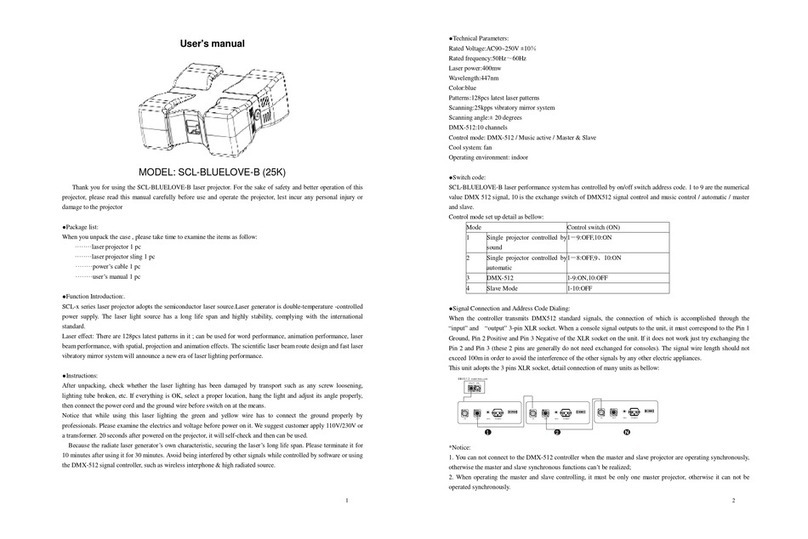
SUPER-CAN
SUPER-CAN SCL-BLUELOVE-B user manual
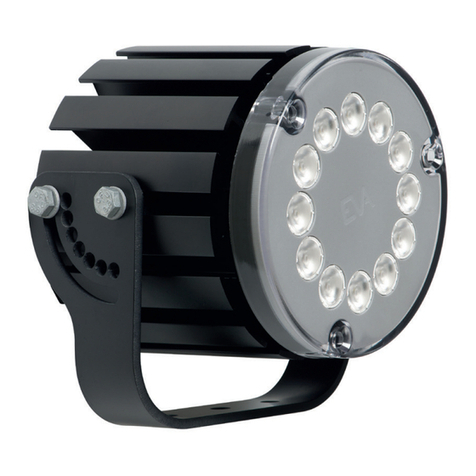
EVA
EVA EVA-HY Series Mounting Installation Instructions
Stairville
Stairville Pixel Panel 144 RGB user manual
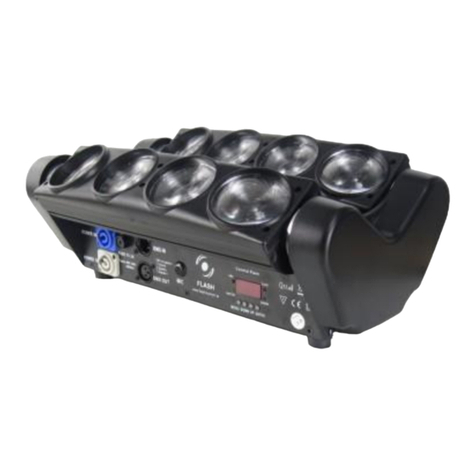
Flash
Flash F7300215 user manual
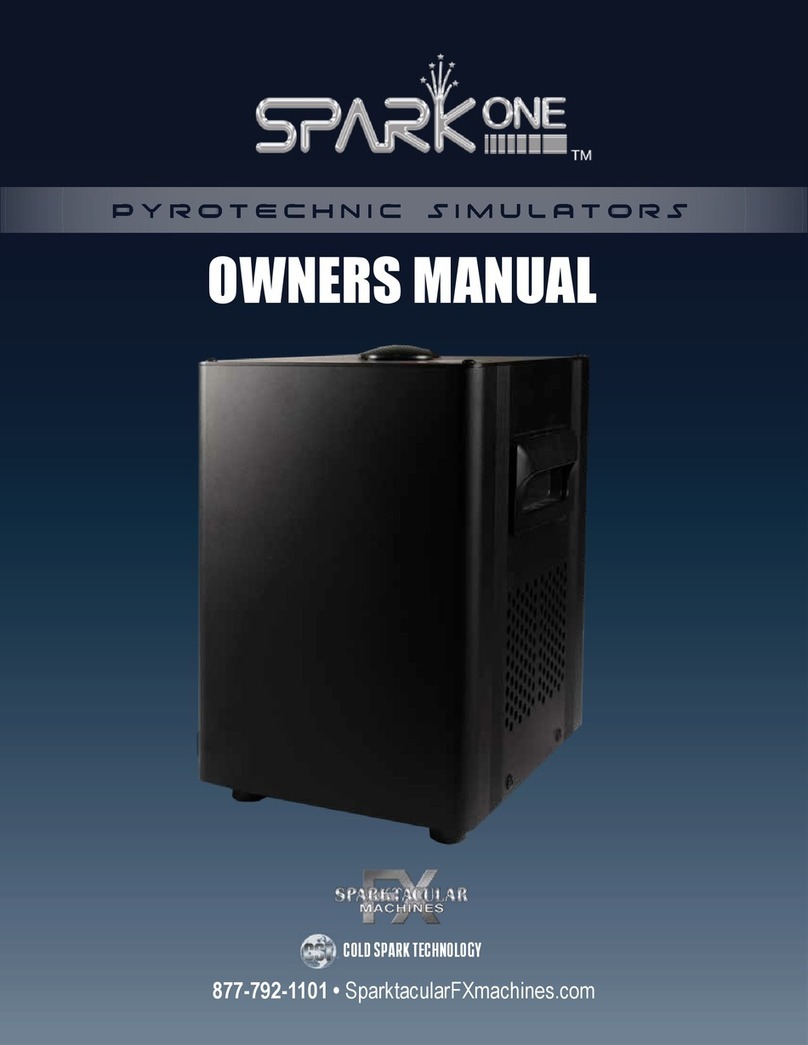
Sparktacular FX Machines
Sparktacular FX Machines SparkOne owner's manual
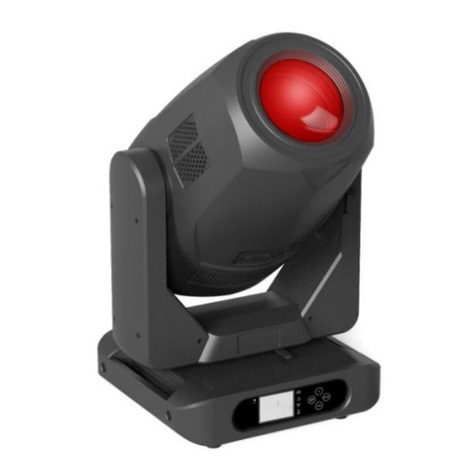
Event Lighting
Event Lighting ENFORCER580 user manual
